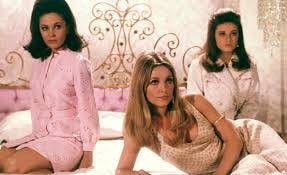Reading Blog 9
A not so Sacred Valley of the Dolls
Quote from Making Machu Picchu:
“Alpaca coats and skirts increased in popularity in the United States during the late 1960s and early 1970s, while the New York Jets star quarterback Joe Namath appeared in magazines displaying his llama hair carpet-covered Manhattan bachelor pad.” (pg 122)
My mind has a cherished technicolour place for the late 1960s and early 1970s. I have an affinity for the vogue of structured silhouettes, popsicle colours, and colourblocking of the era. Through my endless scrounging on The RealReal and rewatching movies from the late Golden Age of Hollywood, I’ve noticed an intertwining of alpaca clothing with iconic fashion moments of the late 1960s and early 1970s. The rise of alpaca wool in the mainstream, as mentioned in the quote, was probably partially due to its features in the media. Alpaca clothing to me has always been associated with an opulence of this time. Differing from Andean patterns, alpaca clothing that I immediately think of is Holly Golightly’s orange coat in Breakfast at Tiffany’s and vintage wool blend Chanel suits. My first interaction with alpaca wool was actually in a mention in the book Valley of the Dolls. The book and movie are salacious, soapy, and campy (and I highly recommend them). They follow the rise and subsequent fall of three youthful and beautiful women in late Hollywood Golden Age. To cope with the pressures of stardom, the story examines female fragility as they turn to pill popping (the titular dolls) as their lives unravel messily. By no means a feminist tale, it features a disillusionment of late 1960s social norms expected of women in a consumerist America. So not really any immediate connection to Peru. The alpaca wool used to costume their upwards mobility and glamour was fully removed from its Andean origin and praised as a luxurious fabric in late capitalist America.
While alpaca clothing gained popularity in the global north, Peru was undergoing agrarian reform. As we’ve read previously, even though agrarian reform redistributed land, it left many campesinos in economically precarious situations. Raising alpaca wool obviously requires land, and alpaca wool exists in the luxury goods market globally. I’m wondering, has the limited land available to raise alpaca contributed to its scarcity, and subsequent high price? The softness of alpaca wool is a major selling point and a viable reason it's sought after, but if it were able to be mass produced it would be more accessible. I’m skeptical if alpaca wool profits are reflective of their international value given the poverty many campesinos experience in Peru. The beautiful alpaca clothing worn by the tortured heroines in Valley of the Dolls must’ve exploited the people of the Andes. Was decontextualizing alpaca wool from the Sacred Valley an intentional means of separating an ugly means of production from a beautiful product? The film/book is the epitome of white women problems (not to say the topics dealt with aren’t complex), and part of the wallowing in glitz requires a certain ignorance of the political and economic state of the world.
However, present-day Cusco is riddled with alpaca wool clothing stores. Sweaters range from wholesale 30 soles acrylic blends, to boutiques around Plaza de Armas with nothing for less than two hundreds of dollars. Most of us are leaving our time in Peru with an alpaca wool product. In the context of commodifying the highlands for tourist consumption, alpaca wool has been a successful enterprise. However, I’m still skeptical of who the actual economic beneficiaries are as the global market struggles to recognize the Indigenous roots of alpaca wool.




Hi Ana,
I was looking forward to reading this post since you told me about it and now I finally had the time! You draw super interesting and relevant connections between the opulence of the global north in the 60s and its failure to acknowledge the ugly means of production from where it came, and the current reality. I just read Andree's comment, and it, in combination with your post, reminded me of Mariategui; the alpaca textile industry is yet another example of how Peru's economy still operates under the control of foreign markets and interests that exploit the land and labour of Indigenous peoples and/or campesinos. I love that you point out how it is a very privileged position to be able to ignore the political and economic state of the world. Thank you for the incredible post as always!
Take care,
Hi Ana:)
I enjoyed reading your blog! Thank you for sharing about the history Alpaca wool and how it has been commodified in western countries. On our first day in Cusco I stumbled across the "Museum & Alpaca Boutique" in the Plaza de Armas where I learned about the different camelids who's wool is used to make these fine clothing. Frank W. Michell from Cornwall, England actually arrived in Arequipa in 1922 and discovered quite a bit about these animals and how their fibers have been used in traditional weaving practices. In 1931 Michell & Co. was founded and as the first company to export sorted and washed alpaca fibre. By 1945the company established its first spinning mill in Peru, creating the Alpaca textile industry in the country. From there the company has only expanded and Michell's descendants have continued to run the the company which is now the Michell Group. It includes the majority of the high-end stores that we see in Cusco and even in Pisac (MFH Knits, Michell Rugs & Carpets, SOL Alpaca, SOL Vicuna, patapampa Alpaca Apparel, Alpaca Factory Outlet, Mundo Alpaca, AMANO, and tejer is COOL). As this group seems to have capitalized on the majority of the high end camelid products coming out of Peru, I expect most of the profits are leaving the country. Hopefully these stores are al least providing jobs for the local communities and paying them fair wages.